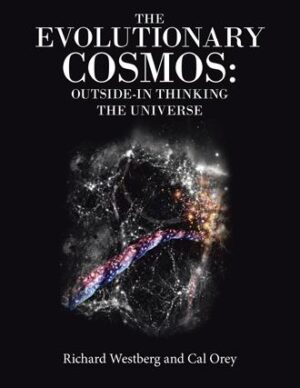Title: The Evolutionary Cosmos: Outside-In Thinking the Universe
Authors: Richard Westberg and Cal Orey
Publisher: AuthorHouse
ISBN: 978-1-6655-5472-5
Pages: 126
Genre: Science / Cosmology
Reviewed by: Jason Lulos
Hollywood Book Reviews
 A theory of everything? The Legos of the Universe? Speculative works in theoretical physics, such as The Evolutionary Cosmos, sometimes seem to contain elements of mysticism and that is because, in their ruminations about the mysteries of the Universe and the bizarre manifestations of quantum mechanics, they seek to explain what is seemingly inexplicable. In The Evolutionary Cosmos, the authors have presented a holistic notion which has threads running through cosmology, biology, and the subatomic. In their proposed theory, they have rendered a fascinating and bewildering account for cosmological events and the very building blocks of all substances in the Universe.
A theory of everything? The Legos of the Universe? Speculative works in theoretical physics, such as The Evolutionary Cosmos, sometimes seem to contain elements of mysticism and that is because, in their ruminations about the mysteries of the Universe and the bizarre manifestations of quantum mechanics, they seek to explain what is seemingly inexplicable. In The Evolutionary Cosmos, the authors have presented a holistic notion which has threads running through cosmology, biology, and the subatomic. In their proposed theory, they have rendered a fascinating and bewildering account for cosmological events and the very building blocks of all substances in the Universe.
This work began as a series of conversations on a family camping trip. Amidst discussions on general relativity and dark matter, the subject invariably turned to gravity and magnetism. The scientific community freely admits that we know almost nothing about dark matter and dark energy (only evidence that they must exist) and we have only a functional account for how gravity works. With all of this in mind, those camping conversations lead to research, thought experiments and the all-important creation of a theoretical idea called “Shaylik.” This is based upon the author’s granddaughter’s name (Shayla). Shaylik is a one-dimensional part of matter that can combine with other Shaylik to form higher dimensional dualistic forms, similar to a double helix that can move at light speeds while being able to pass through all other matter because of its infinite smallness and ability to curve. This is a “collective force system” which, in theory, could explain anything from dark matter to gravity to magnetism to interplanetary events and conjunctions. It is a bold conjecture and thought-provoking to say the least.
Shaylik is then discussed in applications: CMEs (Coronal Mass Ejections), Chirality, time dilation, dust storms on Mars, ice volcanoes, and even the structure of our own DNA. In a particularly interesting chapter on fractals, there is the idea that this double-roped Shaylik might be more than the building blocks of the universe: it might also manifest in other basic structures like DNA. Ideas like this make The Evolutionary Cosmos even more alluring because it is holistic. If this structure, theoretical and speculative though it may be, turns out to be true, then the Legos of the Universe (Shaylik) have a form that is seen, like a fractal, in all types of matter. It is, as the saying on infinite regress goes, “turtles all the way down.”
This is quite a thought-provoking book. It is written in layman’s terms for the most part, but some of the ideas are necessarily a little above the strata of “cosmology for beginners.” Richard Westberg brings an open-minded and scientific fascination to this work. Cal Orey brings the angle of a journalist and best-selling author who’s written on health, science, and sci-fi thrillers and adventure. This combination works quite well, providing personal asides, personal research, thought experiments, and deeper reflections on the unsolved mysteries of the Universe. Regarding the holism of this book, the authors adhere to “outside-in” thinking such as the title depicts. So, this is coming at the problem with the notion of “thinking outside of the box” but more accurately, the book applies a cosmological approach (outside) to go along with the subatomic (inside): another twist of perspective that makes the ideas discussed all the more intriguing. Definitely a must read for science enthusiasts and especially those interested in a different (outsider’s) take on cosmology and the unexplained.

